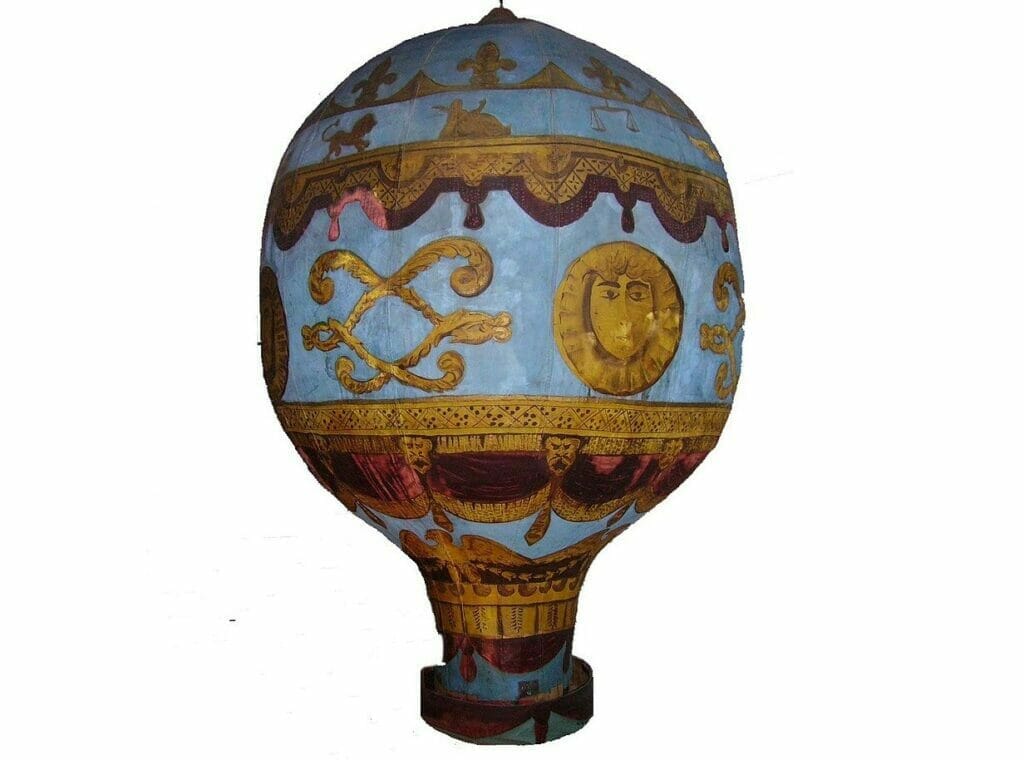A hot air balloon is a relatively simple aircraft. It is just a thin fabric balloon with a wicker basket underneath (with burners, gas tanks, people and stuff). And that part is a bit strange. We have so many different materials now and yet hot air balloons are still using woven baskets – why weren’t they replaced with something made with modern composites? Shouldn’t we be worried about the flammability of wicker?

It is believed that hot air balloons originated from the traditional Chinese paper lanterns. They were used as a signaling devices by the military strategist Zhuge Liang, who lived in 181-234 AD, but it is likely that flying paper lanterns were invented much earlier.
The hot air balloon as an aircraft was invented by French brothers Joseph-Michel and Jacques-Étienne Montgolfier. Their balloon took off for its maiden flight on September 19, 1783, and its first passengers were a rooster, a sheep and a duck. Not much later the Montgolfier balloon was already flying with human passengers and in 1784 hot air balloon was already used as a flying observation and reconaiscence position in battle.

Early Montgolfier balloons had no fuel or fire onboard. They had to be inflated with hot air on the ground and were then released into the wind. This, of course, meant that these simple aircraft, which gave humans their first real chance of flying, did not stay airborne for long.
Hot air balloon passengers have been sitting in wicker baskets for about a couple of centuries. In the age of innovation it seems like an old tecnology. During this time, humans developed many different materials that are easier to process, lighter, and flame-resistant. So why are people still sitting in wicker baskets? Aren’t they too flammable for that kind of application?
Why hot air balloons have wicker baskets?
There are several good reasons why hot air balloons still use wicker baskets even in the 21st century. In fact, wicker baskets are perfect for this application.

Tradition. Did you know that the first wicker furniture was created over five millennia ago? It’s just a traditional way of making things. Woven wicker furniture is still extremely popular and so are wicker hot air balloon baskets.
Aesthetics are very important for hot air balloons. As is tradition – after all, this is the oldest type of people-carrying aircraft. Therefore, hot air balloons are still travelling with bottles of champagne to pay for property damaged during landing. And that’s also why a hot air balloon with a wicker basket has such an iconic image.

Toughness. A wicker basket has no seams and is very strong. In the case of hot air balloons, the bottom is usually made from plywood, but it is still woven into the structure of the basket. Of course, it could be replicated with synthetic materials, but once upon a time, wicker baskets seemed like the most logical solution. Wooden boxes, for example, are made up of individual panels or boards and have many joints and seams – these all all weak spots that wicker baskets do not have. The lack of weak spots make wicker baskets super tough.
Comfort. Wicker baskets are somewhat flexible and they can absorb a lot of energy. Hot air balloon passengers feel this during a harder landing – the basket absorbs some of the force of the impact. The basket itself can flex after contacting the ground or a wall or something, but it is very unlikely to break or transfer that energy to its passengers.

Ventilation. Modern hot air balloons usually use propane for fuel. Of course, gas leaks must be avoided, but if it were to happen, propane would accumulate at the bottom of the basket, because it is heavier than air. This could be dangerous not only because of the risk of fire, but also because propane is an asphyxiating gas. Therefore, the ventilation offered by a wicker basket is an important “just in case” advantage.
Also, wicker baskets allow water to escape as well. Hot air balloon pilots love to skim the surface of a body of water. A wicker basket does not retain water and dries quickly.

Ease of maintenance and repair. Hot air balloon baskets are made by professionals in factories and not some kind of self-taught artisans. However, a basket woven from natural plant material is still easier to maintain and repair than, for example, fibreglass.
Cost. Finally, it is worth mentioning that wicker baskets are relatively cheap. Yes, they are still largely handmade, but fiberglass and other composite materials also require a lot of handwork. So, all things considered, wicker baskets are cheaper than alternatives made of technologically advanced materials.
Fire resistance was mentioned several times in this article. It seems that this should be very important for aircraft that fly with the help of an open flame. However, a professionally maintained hot air balloon should not catch fire. Probability of an accident of this nature is extremely small. Furthermore, if the flame somehow magically turned downwards, it would find something to attack anyway, even if the basket was fire resistant. It wouldn’t be a fun time anyway. Since such accidents are very rare, making hot air balloon baskets from non-flammable materials is not a priority or a safety requirement.

But not all hot air balloon baskets are made of natural materials. Sometimes synthetic fibres are used. There are also collapsible aluminium frame gondolas that are lightweight and take up very little space when disassembled. But most hot air balloons are still flying around with wicker baskets. Even in the 21st century.




